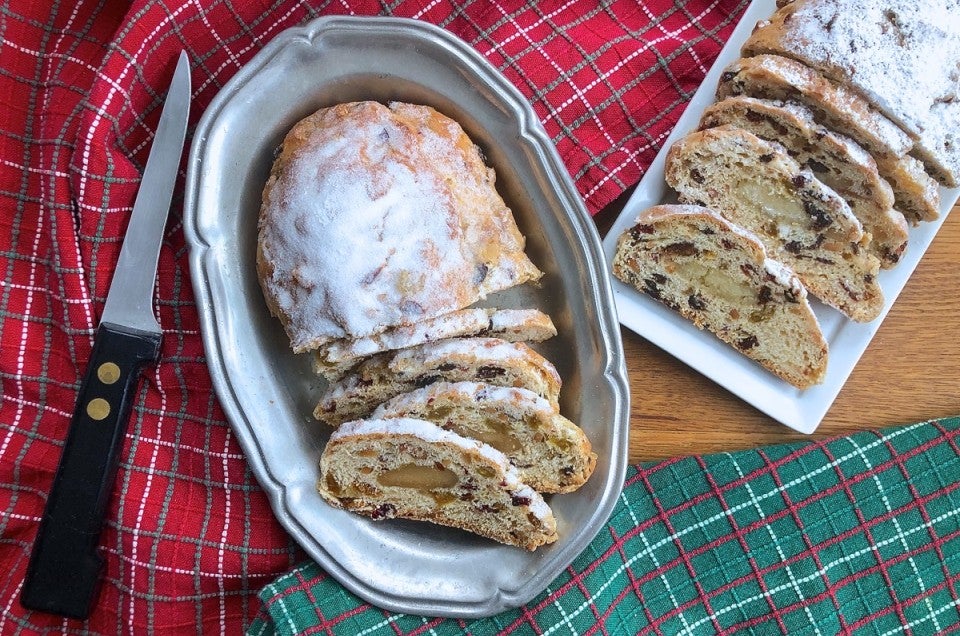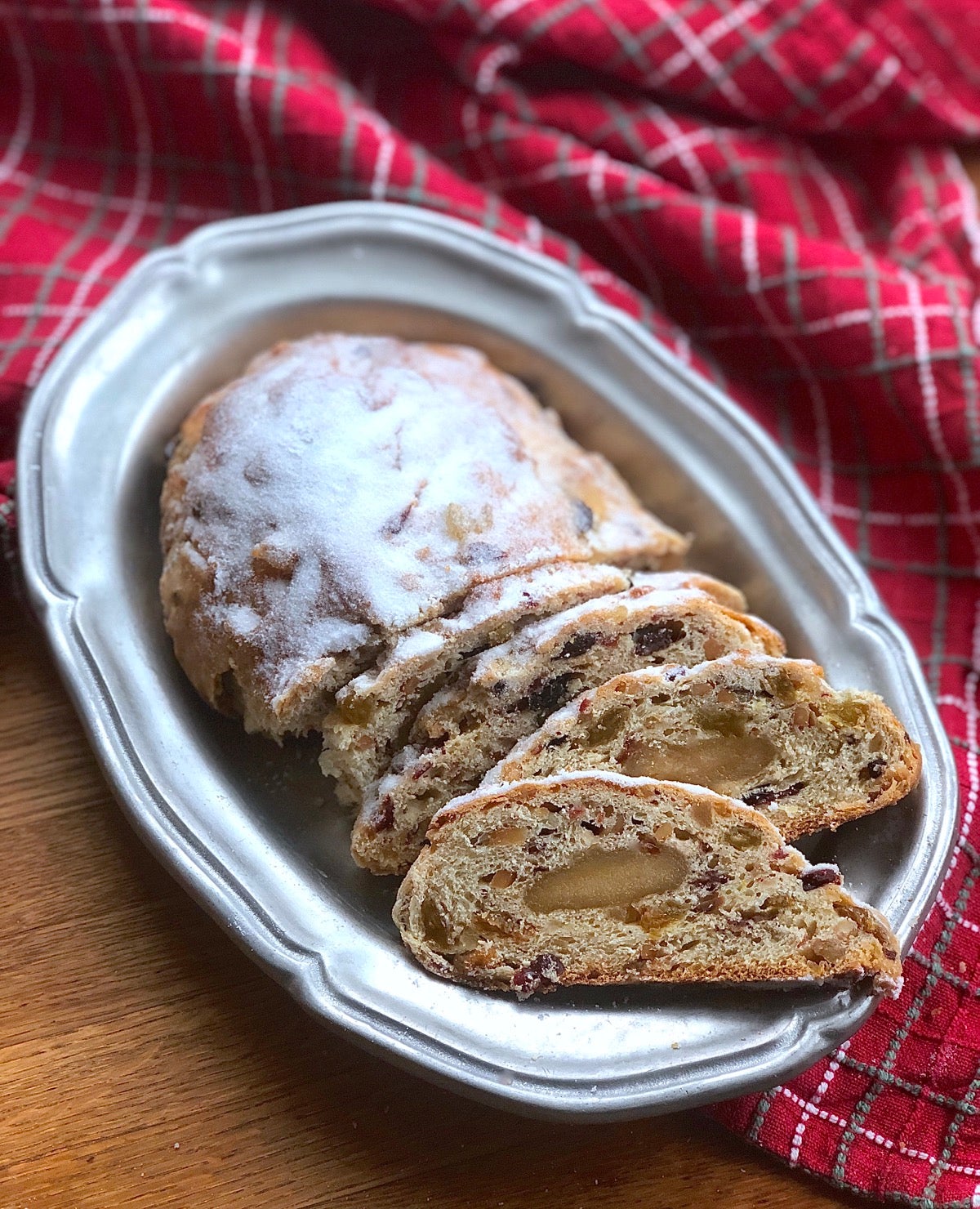


When you think of stollen, what does the word conjure up?
If you’re a fan of this classic German Christmas bread, you probably imagine a cream-colored slice of almond- and lemon-scented yeast bread loaded with your favorite dried fruits and toasted nuts, layered with aromatic almond filling, and showered with a blizzard of snowy sugar.
If you’ve had an unfortunate stollen experience in the past, your memory probably runs more toward unpleasantly bitter fruit inside dry bread with a cloying layer of pasty confectioners’ sugar on top.
Stollen, like fruitcake, is one of those Christmas treats that can run the gamut from superb to shameful. Sure, that boxed stollen someone sent you has probably seen its glory fade over the weeks (perhaps months) of wending its way from mass production bakery to virtual store shelf to mail stream and finally to your home.

But fresh homemade stollen? That’s a completely different story. To our American tastes, shaped as they are by the soft white bread and gooey breakfast buns of childhood, European holiday breads can seem dry; and stollen is no exception. But while the bread itself is a bit austere, the wealth of dried fruits, center strip of luscious almond filling, and crown of buttery sugar give stollen an overall rich mouthfeel, one that nudges you to take another bite — and then another slice.
Here’s what one recipe reviewer says about our Christmas Stollen:
“I've tried any number of times to make Stollen, but until now the results didn't come close to the wonderful Stollen you can find in any bakery in Germany at Christmastime. I even bought a cookbook on German baking, written by a German, who apologized for not including a Stollen recipe, saying she hadn't found anything that really measures up. This recipe cracks the code. I'm so pleased! Thank you King Arthur!”
Are you a stollen-lover looking to make your own — or a stollen-hater eager to change your mind? Either way, start gathering your ingredients: you’re about to discover exactly why stollen is one of the world’s most-storied and best-loved holiday breads.
Fruit
Dough
Filling
Topping

Combine your chosen fruits and juice or liquor, cover, and set aside at room temperature for up to 12 hours. You want to give the fruit enough time to absorb most of the liquid, which takes several hours.
To speed things up, combine the fruit and liquid, cover with plastic wrap, and microwave for 1 to 2 minutes, until hot. The fruit will be ready when it's time to add it to the dough.

Using a stand mixer or bread machine set on the dough cycle, mix and knead together all of the dough ingredients (except the fruit and almonds) to make a smooth, very soft dough.
The dough may be quite sticky; that's OK. Avoid adding additional flour if possible, since this can result in dry bread.

Place the dough in a lightly greased large bowl, cover it airtight so it doesn't dry out, and let it rise until puffy, about 90 minutes to 2 hours.
You have your choice of four fillings here: marzipan, packaged almond paste, homemade almond paste, or sweetened almond butter.
Marzipan is simply almond paste to which sugar has been added, so it's the sweetest of the four.
Packaged and homemade almond paste are quite similar, though homemade is obviously fresher; its flavors really sing. It's also super-simple to make.

You'll need almond flour, confectioners' sugar, an egg white, salt, and almond extract. The following formula makes double the amount of almond paste that you need for the stollen recipe. Either cut the formula in half (using half a large egg white, 17g); or throw the remaining half in the freezer (wrapped, of course) and use it in our delicious Almond Galette, which traditionally wraps up the holiday season on Epiphany, January 6.
Combine 2 cups (192g) almond flour and 1 1/2 cups (170g) confectioners' sugar in a food processor or blender, processing briefly, just to combine.

Add 1 large egg white, 1/8 teaspoon salt, and 1 1/2 teaspoons almond extract (or more, to taste). Process until the mixture comes together and forms a malleable ball.

Remove the almond paste from the processor or blender, scraping any residue from the sides of the bowl or jar. Use the paste right away; or refrigerate it, covered, until ready to use.
Are you worried about using a raw egg white? Don't be; baked inside the stollen, this almond paste reaches the recommended temperature for its egg white to be considered cooked and safe. If you're still anxious, though, choose pasteurized eggs as your source.
Sweetened almond butter, the brainchild of long-time King Arthur baker/writer Susan Reid, is a bit softer and more challenging to work with than almond paste or marzipan, but adds wonderful nutty-sweet flavor to stollen.
To make sweetened almond butter, purchase prepared almond butter; the processed kind, rather than fresh-ground, makes a smoother filling. Blend together two parts almond butter to one part confectioners' sugar by weight.
To make enough filling for this recipe, blend together 1/2 cup (130g) almond butter and a heaping 1/2 cup (65g) confectioners' sugar until smooth. A food processor or blender works well here.
Divide the filling of your choice into three pieces and shape each into a flattened 7" log. If you've chosen sweetened almond butter you'll find it's more sticky than malleable.

Spread a 7" strip of filling onto a piece of parchment or waxed paper, then refrigerate until you're ready to use it; this will make it a bit easier to handle.

If you haven't done so already, toast your almonds in a preheated 350°F oven until they're a light golden brown, about 6 to 8 minutes. Remove them from the oven and let them cool briefly before using.
Knead the fruit and almonds into the dough. Be sure to flour your work surface thoroughly; the dough will be fairly sticky with the added fruit.

Turn the dough out onto a lightly greased surface, divide it into three pieces, and shape each piece into an 8" x 6" oval.

Place one log of almond paste or marzipan onto each oval, offsetting it just a bit towards the right edge. Counterintuitively, placing the filling a bit off-center will help it end up in the center of the baked stollen.

Fold the left side of the dough over the right side lengthwise, leaving the edge of the top piece of dough just shy of the bottom edge. Press the top edge firmly to seal it to the dough below.

Place the loaves on a lightly greased or parchment-lined baking sheet.

Cover the stollen and let them rise for 45 to 60 minutes, until puffy.
While the stollen are rising, preheat the oven to 350°F with a rack in the upper third.
When the stollen are noticeably puffy, uncover them and place them in the oven. Bake the stollen for 30 to 35 minutes, until golden brown and the internal temperature reads 190°F on a digital thermometer.

Remove the stollen from the oven.

Brush the stollen with the melted butter.

After 5 minutes, shower heavily with superfine sugar and/or confectioners' or non-melting sugar.
It’s up to you!
Superfine sugar yields a lush, almost velvety coating. Sprinkled atop the brushed-on butter, it's nearly glaze-like in its softness.
Confectioners’ sugar and non-melting sugar are lighter and whiter than superfine sugar. If you’re going to serve stollen within a day, confectioners’ sugar is an appropriate choice. But confectioners’ sugar can dissolve into the butter beneath it over time, leaving your stollen naked. If you’d like to use confectioners’ sugar, be prepared to re-sugar your loaf before serving.
Non-melting sugar, as its name indicates, won’t disappear; it’s a better choice for stollen that’ll be stored for a while.

Transfer the stollen to a rack to cool completely. Wrap airtight and store at room temperature for up to two weeks.

Serve room-temperature stollen in thin slices; it needs neither butter nor preserves. Stollen is especially good with tea, coffee, or a glass of wine.
Feel free to substitute our golden whole wheat flour for up to 50% of the all-purpose flour in the recipe. Your stollen will probably be denser and potentially a bit crumbly due to the bran in whole wheat flour.
Any kind of yeasted stollen, including our Christmas Stollen, won’t lend itself well to gluten-free flour substitutions. But don’t despair! Our Easiest Stollen relies on baking powder for its leavening. Substitute our Gluten-Free Measure for Measure Flour for the all-purpose flour in the recipe, and you’ll make a quick-and-easy stollen perfect for any gluten-free crowd. And remember, if you’re serving this stollen to anyone with severe issues around gluten, make sure that all of the ingredients you use are certified gluten-free.

It's true, stollen is somewhat of a project. But the steps, though many, are straightforward. And the result is well worth the effort: you're participating in a baking tradition with stollen fans all over the world. Happy holidays!
If you'd like to try baking with homemade almond paste this season, here's our full recipe to get you started: DIY Almond Paste.